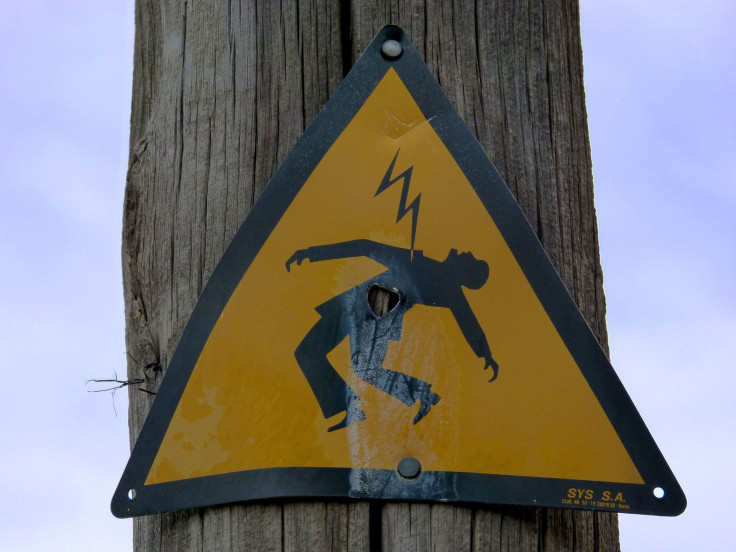Breaking Point: What's The Strongest Electric Shock Humans Can Handle?

We use electricity every day to wake up, light our homes, and cook our food, among other tasks. When we’re left without power, we lose so many of the amenities we’ve grown used to in the modern age that we're plunged back into a colonial-esque few hours during which we resort to candles and board games.
Despite how much it has helped us, electricity is nothing you want to get overly familiar with. The little static shocks you get by touching a doorknob or a metal appliance are nothing compared to what electricity is capable of doing to you. After all, we know we should avoid being struck by lightning or dropping a hairdryer in the bathtub, but why? How does electricity harm us, and how strong of a current can we take before it’s all over?
Nuts And Volts
To understand how electricity can mess with our bodies, we have to be familiar with electricity itself. Electricity is the movement of electrons, which create charge. We harness these charges to do work (like lighting a lightbulb), and the behavior of these electrons determines what we think of as the strength of an electric charge.
Hopefully everyone knows to stay away from things marked “high voltage,” but most of us don’t really know what that means. Voltage measures the difference in charge between two points, like a wire and the ground. This is closely related to current, which is the flow rate of electrons. These two factors make up a lot of what determines how dangerous a source of electricity is for humans.
Anyone who had to complete the wire and battery experiment in middle school knows electricity requires a complete circuit to flow. Our bodies can complete circuits if we come between two objects differing in charge. A mild example is the shock you get when you grab a doorknob — it’s fleeting because the static charges between the doorknob and the ground equalize quickly. The voltage between the doorknob and ground isn’t very high, so a ton of electrons aren’t motivated to jump through our body to the ground.
Shocking Developments
Little shocks we get from static-prone clothing and everyday household surfaces aren’t powerful enough to damage our bodies. Very low currents can be imperceptible; after all, our body relies on electrical impulses to make things like neural communication possible. It’s once the voltage and current get too high in combination that we’re uncomfortably shocked.
Various factors determine when an electrical current becomes dangerous, including our skin itself. Our skin is the body’s natural resistance to electricity, since internal tissues and organs are much more vulnerable. But there’s a good reason they tell you to keep the hairdryer out of the bathtub: Wet or damaged skin is 100 times more susceptible to electricity than dry, undamaged skin.
Whether it’s a small or large shock, an electrical current can disturb several body systems. The skin can suffer burns when it comes in contact with electricity due to heating, an effect of resistance. Though painful, those are the least of a person’s worries as shocks get more and more powerful.
The nervous system, which is responsible for the many signals that regulate bodily functions, communicates through neurotransmitters. Electrical signals usually stimulate neurons to release neurotransmitters, but if an electric current is conducted through the body, this process can be severely disrupted.
The foreign current will overload the nervous system, preventing many important bodily functions like reflexes and heartbeat. A shock can cause the heart to fall into fibrillation, a state of fluttering rather than beating, which is ineffective at pumping blood through the body. Ironically, paramedics will often use a defibrillator to shock the heart a second time, jolting it back into its normal rhythm.
A second dangerous part of nervous system disruption is called tetanic contraction, or tetanus. Not to be confused with the bacteria-caused disease, tetanus occurs when muscles involuntarily contract due to an overload of electrical impulses. This can be especially problematic if a person’s hand is around a conductor when they’re shocked — it’s the reason those being electrocuted can’t seem to let go of the source of their shock.
Those who survive serious electric shocks can experience loss of consciousness, seizures, aphasia, headaches, and memory disturbances as a result of their ordeal.
An Electric Execution
It’s pretty obvious how electricity can kill us — if our heart isn’t beating, oxygen isn’t getting to the brain, and we’re toast within minutes. But at what level is electricity dangerous, or lethal? Perhaps this isn’t the most helpful answer, but honestly, it depends. Current level, voltage, skin resistance, duration, and current pathway all play a role in how much a shock will damage the body. For example, a bolt of lightning may have the power to kill us, but if the current takes a pathway through the body that doesn’t include the heart, we may survive. On the flip side, a comparatively minor shock directly to the heart can be deadly.
People have suffered from fibrillation because of zaps as low as 49 volts. Tasers, however, can reach 50,000 volts. Volts simply carry the current though, which is measured in amps. When it comes to amps, we aren’t very good at keeping it together. The Physics Department at Ohio State lists 0.01 amps (10 milliamps) as the threshold for a painful shock, and anything above that level as causing tetanus. Currents between 100 and 200 milliamps are likely fatal. Again, this depends on duration and several other factors.
There is no hard and fast rule about how much electricity we can take before we’re irreversibly damaged, but a good rule of thumb is this: Avoid live electrical wires, high voltage sites, and any other unfamiliar objects humming with electricity unless you’re trained to work with them. Oh, and keep those hair styling appliances away from your bubble bath, too.
Published by Medicaldaily.com



























